automatic transmission JEEP WRANGLER UNLIMITED 2021 Owner handbook (in English)
[x] Cancel search | Manufacturer: JEEP, Model Year: 2021, Model line: WRANGLER UNLIMITED, Model: JEEP WRANGLER UNLIMITED 2021Pages: 330, PDF Size: 9.16 MB
Page 148 of 330
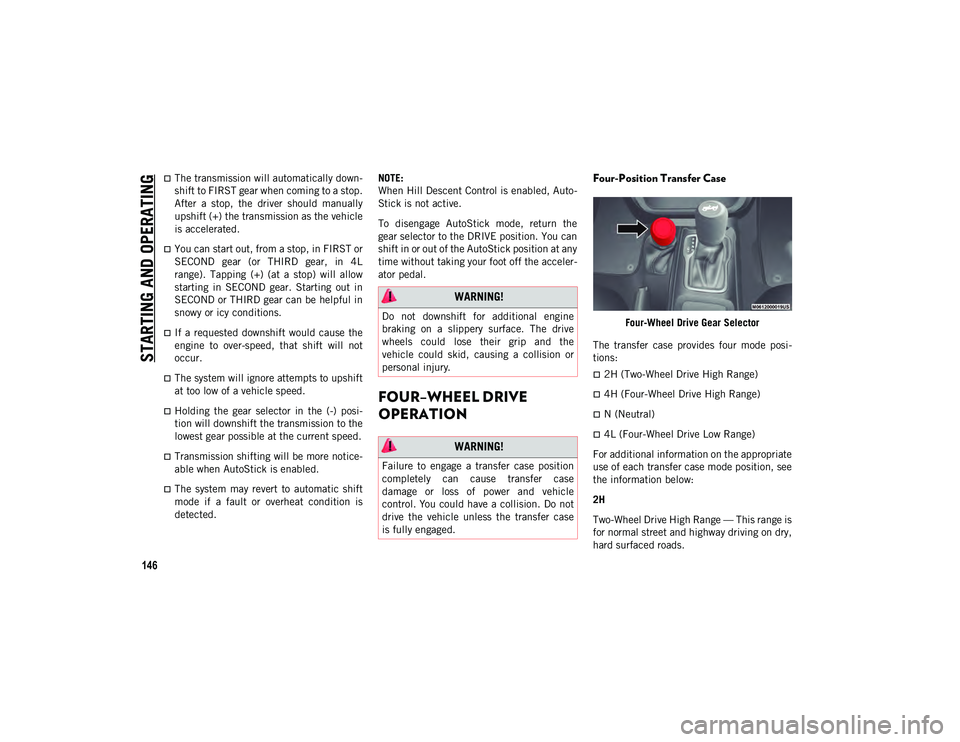
STARTING AND OPERATING
146
’ü»The transmission will automatically down-
shift to FIRST gear when coming to a stop.
After a stop, the driver should manually
upshift (+) the transmission as the vehicle
is accelerated.
’ü»You can start out, from a stop, in FIRST or
SECOND gear (or THIRD gear, in 4L
range). Tapping (+) (at a stop) will allow
starting in SECOND gear. Starting out in
SECOND or THIRD gear can be helpful in
snowy or icy conditions.
’ü»If a requested downshift would cause the
engine to over-speed, that shift will not
occur.
’ü»The system will ignore attempts to upshift
at too low of a vehicle speed.
’ü»Holding the gear selector in the (-) posi -
tion will downshift the transmission to the
lowest gear possible at the current speed.
’ü»Transmission shifting will be more notice-
able when AutoStick is enabled.
’ü»The system may revert to automatic shift
mode if a fault or overheat condition is
detected. NOTE:
When Hill Descent Control is enabled, Auto
-
Stick is not active.
To disengage AutoStick mode, return the
gear selector to the DRIVE position. You can
shift in or out of the AutoStick position at any
time without taking your foot off the acceler -
ator pedal.
FOURŌĆōWHEEL DRIVE
OPERATION
Four-Position Transfer Case
Four-Wheel Drive Gear Selector
The transfer case provides four mode posi -
tions:
’ü»2H (Two-Wheel Drive High Range)
’ü»4H (Four-Wheel Drive High Range)
’ü»N (Neutral)
’ü»4L (Four-Wheel Drive Low Range)
For additional information on the appropriate
use of each transfer case mode position, see
the information below:
2H
Two-Wheel Drive High Range ŌĆö This range is
for normal street and highway driving on dry,
hard surfaced roads.
WARNING!
Do not downshift for additional engine
braking on a slippery surface. The drive
wheels could lose their grip and the
vehicle could skid, causing a collision or
personal injury.
WARNING!
Failure to engage a transfer case position
completely can cause transfer case
damage or loss of power and vehicle
control. You could have a collision. Do not
drive the vehicle unless the transfer case
is fully engaged.
2020_JEEP_JL_WRANGLER_UG_RHD_UK.book Page 146
Page 149 of 330
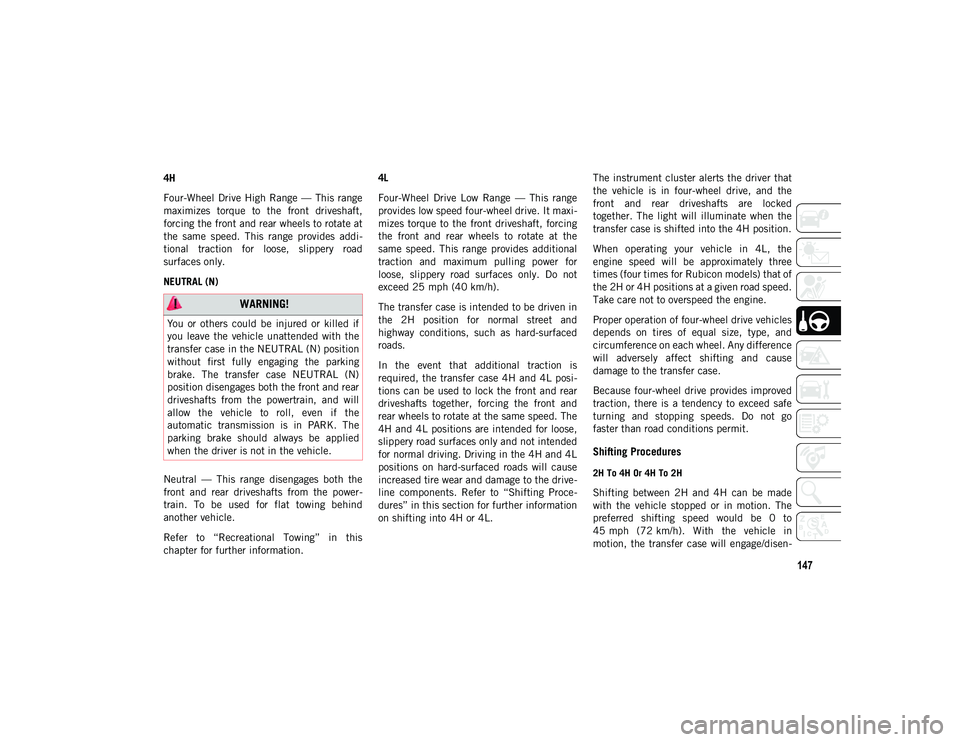
147
4H
Four-Wheel Drive High Range ŌĆö This range
maximizes torque to the front driveshaft,
forcing the front and rear wheels to rotate at
the same speed. This range provides addi-
tional traction for loose, slippery road
surfaces only.
NEUTRAL (N)
Neutral ŌĆö This range disengages both the
front and rear driveshafts from the power -
train. To be used for flat towing behind
another vehicle.
Refer to ŌĆ£Recreational TowingŌĆØ in this
chapter for further information. 4L
Four-Wheel Drive Low Range ŌĆö This range
provides low speed four-wheel drive. It maxi
-
mizes torque to the front driveshaft, forcing
the front and rear wheels to rotate at the
same speed. This range provides additional
traction and maximum pulling power for
loose, slippery road surfaces only. Do not
exceed 25 mph (40 km/h).
The transfer case is intended to be driven in
the 2H position for normal street and
highway conditions, such as hard-surfaced
roads.
In the event that additional traction is
required, the transfer case 4H and 4L posi -
tions can be used to lock the front and rear
driveshafts together, forcing the front and
rear wheels to rotate at the same speed. The
4H and 4L positions are intended for loose,
slippery road surfaces only and not intended
for normal driving. Driving in the 4H and 4L
positions on hard-surfaced roads will cause
increased tire wear and damage to the drive -
line components. Refer to ŌĆ£Shifting Proce -
duresŌĆØ in this section for further information
on shifting into 4H or 4L. The instrument cluster alerts the driver that
the vehicle is in four-wheel drive, and the
front and rear driveshafts are locked
together. The light will illuminate when the
transfer case is shifted into the 4H position.
When operating your vehicle in 4L, the
engine speed will be approximately three
times (four times for Rubicon models) that of
the 2H or 4H positions at a given road speed.
Take care not to overspeed the engine.
Proper operation of four-wheel drive vehicles
depends on tires of equal size, type, and
circumference on each wheel. Any difference
will adversely affect shifting and cause
damage to the transfer case.
Because four-wheel drive provides improved
traction, there is a tendency to exceed safe
turning and stopping speeds. Do not go
faster than road conditions permit.
Shifting Procedures
2H To 4H Or 4H To 2H
Shifting between 2H and 4H can be made
with the vehicle stopped or in motion. The
preferred shifting speed would be 0 to
45 mph (72 km/h). With the vehicle in
motion, the transfer case will engage/disen
-
WARNING!
You or others could be injured or killed if
you leave the vehicle unattended with the
transfer case in the NEUTRAL (N) position
without first fully engaging the parking
brake. The transfer case NEUTRAL (N)
position disengages both the front and rear
driveshafts from the powertrain, and will
allow the vehicle to roll, even if the
automatic transmission is in PARK. The
parking brake should always be applied
when the driver is not in the vehicle.
2020_JEEP_JL_WRANGLER_UG_RHD_UK.book Page 147
Page 151 of 330
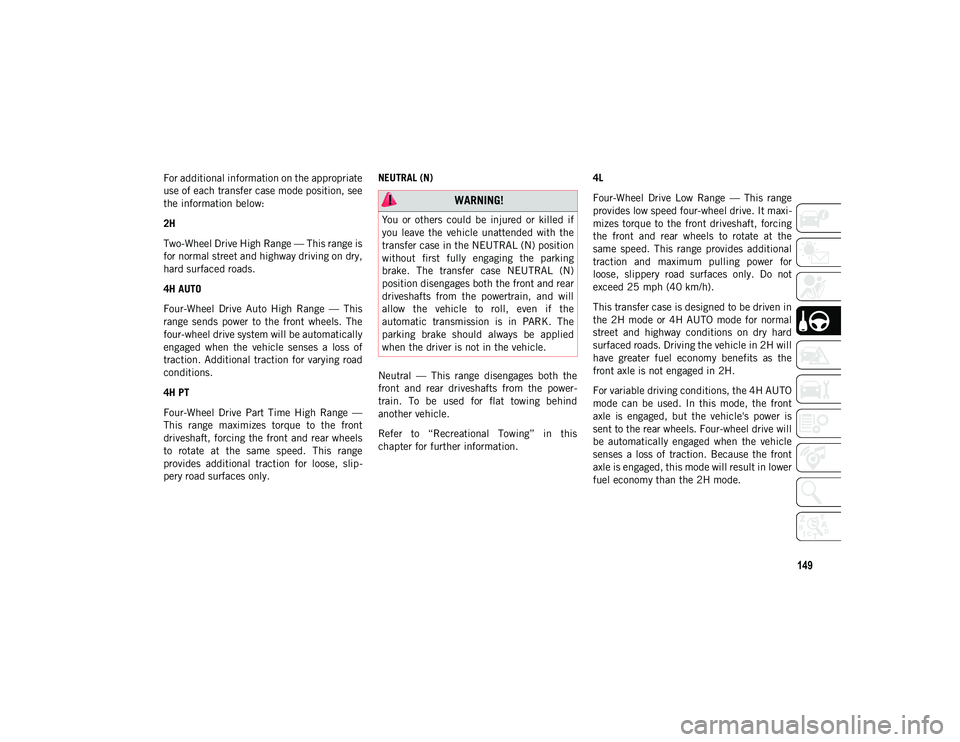
149
For additional information on the appropriate
use of each transfer case mode position, see
the information below:
2H
Two-Wheel Drive High Range ŌĆö This range is
for normal street and highway driving on dry,
hard surfaced roads.
4H AUTO
Four-Wheel Drive Auto High Range ŌĆö This
range sends power to the front wheels. The
four-wheel drive system will be automatically
engaged when the vehicle senses a loss of
traction. Additional traction for varying road
conditions.
4H PT
Four-Wheel Drive Part Time High Range ŌĆö
This range maximizes torque to the front
driveshaft, forcing the front and rear wheels
to rotate at the same speed. This range
provides additional traction for loose, slip-
pery road surfaces only. NEUTRAL (N)
Neutral ŌĆö This range disengages both the
front and rear driveshafts from the power
-
train. To be used for flat towing behind
another vehicle.
Refer to ŌĆ£Recreational TowingŌĆØ in this
chapter for further information. 4L
Four-Wheel Drive Low Range ŌĆö This range
provides low speed four-wheel drive. It maxi
-
mizes torque to the front driveshaft, forcing
the front and rear wheels to rotate at the
same speed. This range provides additional
traction and maximum pulling power for
loose, slippery road surfaces only. Do not
exceed 25 mph (40 km/h).
This transfer case is designed to be driven in
the 2H mode or 4H AUTO mode for normal
street and highway conditions on dry hard
surfaced roads. Driving the vehicle in 2H will
have greater fuel economy benefits as the
front axle is not engaged in 2H.
For variable driving conditions, the 4H AUTO
mode can be used. In this mode, the front
axle is engaged, but the vehicle's power is
sent to the rear wheels. Four-wheel drive will
be automatically engaged when the vehicle
senses a loss of traction. Because the front
axle is engaged, this mode will result in lower
fuel economy than the 2H mode.
WARNING!
You or others could be injured or killed if
you leave the vehicle unattended with the
transfer case in the NEUTRAL (N) position
without first fully engaging the parking
brake. The transfer case NEUTRAL (N)
position disengages both the front and rear
driveshafts from the powertrain, and will
allow the vehicle to roll, even if the
automatic transmission is in PARK. The
parking brake should always be applied
when the driver is not in the vehicle.
2020_JEEP_JL_WRANGLER_UG_RHD_UK.book Page 149
Page 155 of 330
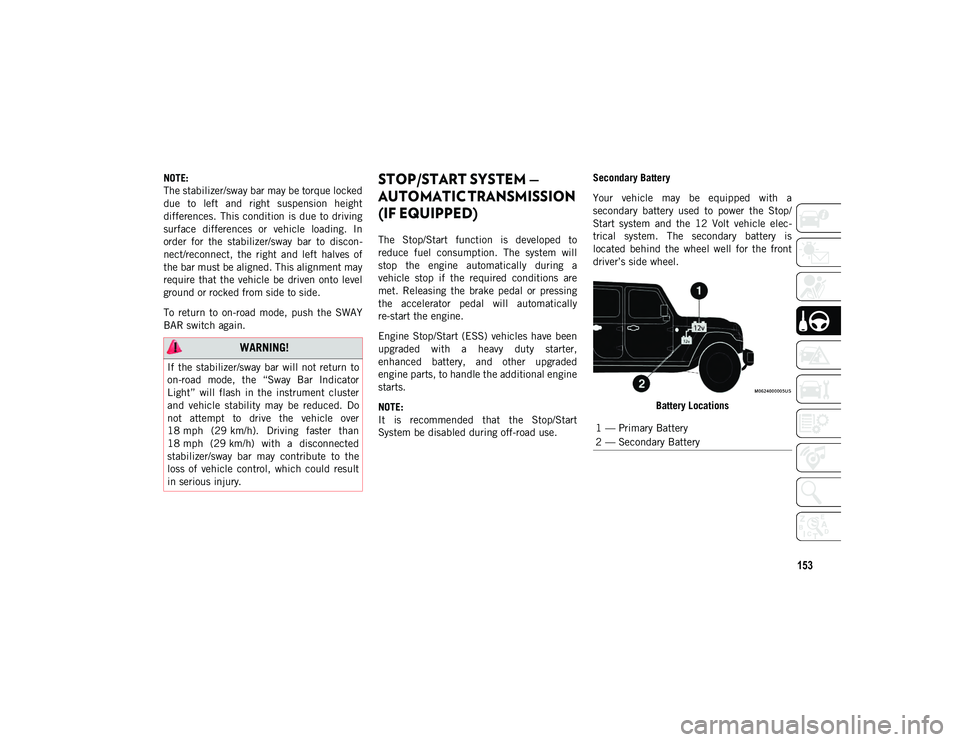
153
NOTE:
The stabilizer/sway bar may be torque locked
due to left and right suspension height
differences. This condition is due to driving
surface differences or vehicle loading. In
order for the stabilizer/sway bar to discon-
nect/reconnect, the right and left halves of
the bar must be aligned. This alignment may
require that the vehicle be driven onto level
ground or rocked from side to side.
To return to on-road mode, push the SWAY
BAR switch again.
STOP/START SYSTEM ŌĆö
AUTOMATIC TRANSMISSION
(IF EQUIPPED)
The Stop/Start function is developed to
reduce fuel consumption. The system will
stop the engine automatically during a
vehicle stop if the required conditions are
met. Releasing the brake pedal or pressing
the accelerator pedal will automatically
re-start the engine.
Engine Stop/Start (ESS) vehicles have been
upgraded with a heavy duty starter,
enhanced battery, and other upgraded
engine parts, to handle the additional engine
starts.
NOTE:
It is recommended that the Stop/Start
System be disabled during off-road use. Secondary Battery
Your vehicle may be equipped with a
secondary battery used to power the Stop/
Start system and the 12 Volt vehicle elec
-
trical system. The secondary battery is
located behind the wheel well for the front
driverŌĆÖs side wheel.
Battery Locations
WARNING!
If the stabilizer/sway bar will not return to
on-road mode, the ŌĆ£Sway Bar Indicator
LightŌĆØ will flash in the instrument cluster
and vehicle stability may be reduced. Do
not attempt to drive the vehicle over
18 mph (29 km/h). Driving faster than
18 mph (29 km/h) with a disconnected
stabilizer/sway bar may contribute to the
loss of vehicle control, which could result
in serious injury.
1 ŌĆö Primary Battery
2 ŌĆö Secondary Battery
2020_JEEP_JL_WRANGLER_UG_RHD_UK.book Page 153
Page 156 of 330

STARTING AND OPERATING
154
Automatic Mode
The Stop/Start feature is enabled
after every normal customer engine
start. At that time, the system will
go into STOP/START READY and if
all other conditions are met, can go into a
STOP/START AUTOSTOP ACTIVE
ŌĆ£AutostopŌĆØ mode.
To Activate The Autostop Mode, The Following
Must Occur:
’ü»The system must be in STOP/START
READY state. A STOP/START READY
message will be displayed in the instru -
ment cluster display within the Stop/Start
section. Refer to ŌĆ£Instrument ClusterŌĆØ in
ŌĆ£Getting To Know Your Instrument PanelŌĆØ
in your OwnerŌĆÖs Manual for further infor -
mation.
’ü»The vehicle must be completely stopped.
’ü»The shifter must be in a forward gear and
the brake pedal depressed.
The engine will shut down, the tachometer
will move to the zero position and the Stop/
Start telltale will illuminate indicating you
are in Autostop. Customer settings will be
maintained upon return to an engine running
condition. Refer to the ŌĆ£Stop/Start SystemŌĆØ in the
ŌĆ£Starting And OperatingŌĆØ section located in
your OwnerŌĆÖs Manual for further information.
Possible Reasons The Engine Does Not
Autostop
Prior to engine shut down, the system will
check many safety and comfort conditions to
see if they are fulfilled. Detailed information
about the operation of the Stop/Start system
may be viewed in the instrument cluster
display Stop/Start Screen. In the following
situations, the engine will not stop:
’ü»DriverŌĆÖs seat belt is not buckled.
’ü»DriverŌĆÖs door is not closed.
’ü»Battery temperature is too warm or cold.
’ü»Battery charge is low.
’ü»The vehicle is on a steep grade.
’ü»Cabin heating or cooling is in process and
an acceptable cabin temperature has not
been achieved.
’ü»HVAC is set to full defrost mode at a high
blower speed.
’ü»HVAC set to MAX A/C.
’ü»Engine has not reached normal operating
temperature.
’ü»Engine temperature too high.
’ü»The transmission is not in a forward gear.
’ü»Hood is open.
’ü»Transfer case is in 4L or Neutral.
’ü»Brake pedal is not pressed with sufficient
pressure.
Other Factors Which Can Inhibit Autostop
Include:
’ü»Accelerator pedal input.
’ü»Vehicle speed threshold not achieved from
previous auto-stop.
’ü»Steering angle beyond threshold. (ESS
Models Only)
’ü»ACC is on and speed is set.
’ü»Vehicle is at high altitude.
’ü»System fault present.
It may be possible for the vehicle to be driven
several times without the Stop/Start system
going into a STOP/START READY state
under more extreme conditions of the items
listed above.
2020_JEEP_JL_WRANGLER_UG_RHD_UK.book Page 154
Page 157 of 330
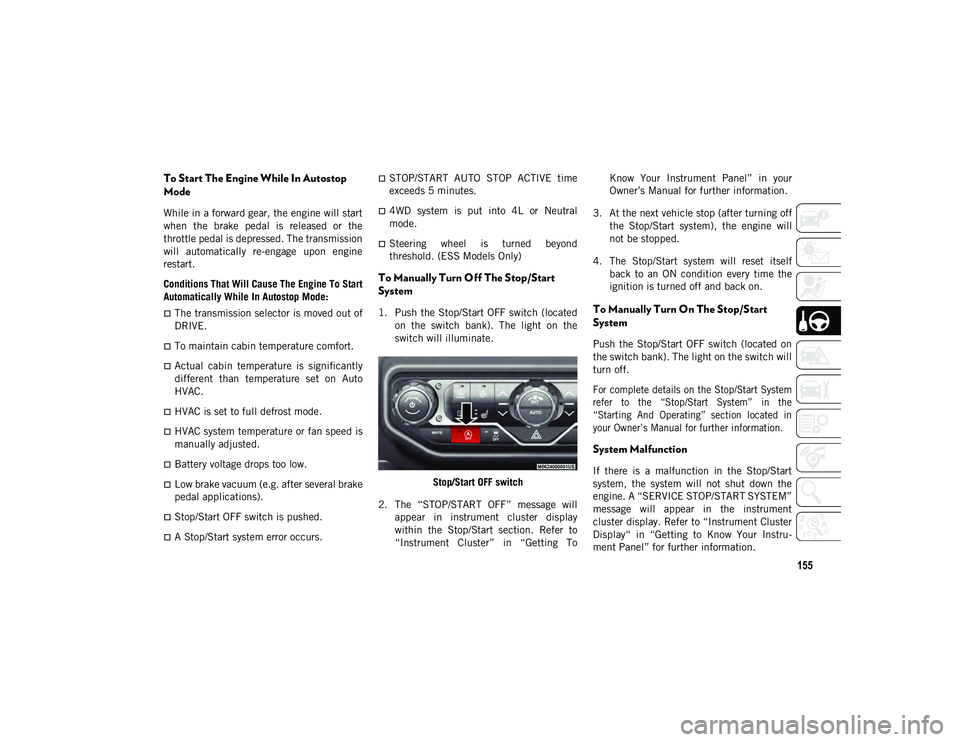
155
To Start The Engine While In Autostop
Mode
While in a forward gear, the engine will start
when the brake pedal is released or the
throttle pedal is depressed. The transmission
will automatically re-engage upon engine
restart.
Conditions That Will Cause The Engine To Start
Automatically While In Autostop Mode:
’ü»The transmission selector is moved out of
DRIVE.
’ü»To maintain cabin temperature comfort.
’ü»Actual cabin temperature is significantly
different than temperature set on Auto
HVAC.
’ü»HVAC is set to full defrost mode.
’ü»HVAC system temperature or fan speed is
manually adjusted.
’ü»Battery voltage drops too low.
’ü»Low brake vacuum (e.g. after several brake
pedal applications).
’ü»Stop/Start OFF switch is pushed.
’ü»A Stop/Start system error occurs.
’ü»STOP/START AUTO STOP ACTIVE time
exceeds 5 minutes.
’ü»4WD system is put into 4L or Neutral
mode.
’ü»Steering wheel is turned beyond
threshold. (ESS Models Only)
To Manually Turn Off The Stop/Start
System
1. Push the Stop/Start OFF switch (located
on the switch bank). The light on the
switch will illuminate.
Stop/Start OFF switch
2. The ŌĆ£STOP/START OFFŌĆØ message will appear in instrument cluster display
within the Stop/Start section. Refer to
ŌĆ£Instrument ClusterŌĆØ in ŌĆ£Getting To Know Your Instrument PanelŌĆØ in your
OwnerŌĆÖs Manual for further information.
3. At the next vehicle stop (after turning off the Stop/Start system), the engine will
not be stopped.
4. The Stop/Start system will reset itself back to an ON condition every time the
ignition is turned off and back on.To Manually Turn On The Stop/Start
System
Push the Stop/Start OFF switch (located on
the switch bank). The light on the switch will
turn off.
For complete details on the Stop/Start System
refer to the ŌĆ£Stop/Start SystemŌĆØ in the
ŌĆ£Starting And OperatingŌĆØ section located in
your OwnerŌĆÖs Manual for further information.
System Malfunction
If there is a malfunction in the Stop/Start
system, the system will not shut down the
engine. A ŌĆ£SERVICE STOP/START SYSTEMŌĆØ
message will appear in the instrument
cluster display. Refer to ŌĆ£Instrument Cluster
DisplayŌĆ£ in ŌĆ£Getting to Know Your Instru -
ment PanelŌĆØ for further information.
2020_JEEP_JL_WRANGLER_UG_RHD_UK.book Page 155
Page 178 of 330

STARTING AND OPERATING
176
(Continued)
(Continued)
RECREATIONAL TOWING (BEHIND MOTORHOME, ETC.)
Towing This Vehicle Behind Another Vehicle
Recreational Towing ŌĆö Four-Wheel Drive
Models
NOTE:
The transfer case must be shifted into
NEUTRAL (N), transmission must be in
PARK, for recreational towing.
Towing Condition Wheels OFF the Ground Four-Wheel Drive Models
Flat TowNONESee Instructions
’ü»Automatic transmission in PARK.
’ü»Transfer case in NEUTRAL (N).
’ü»Disconnect negative battery cable.
’ü»Tow in forward direction.
Dolly Tow Front NOT ALLOWED
Rear NOT ALLOWED
On Trailer ALL OK
NOTE:
When towing your vehicle, always follow applicable laws. Contact local authorities for additional details.
CAUTION!
’ü»DO NOT dolly tow any 4WD vehicle.
Towing with only one set of wheels on
the ground (front or rear) will cause
severe transmission and/or transfer case
damage. Tow with all four wheels either
ON the ground, or OFF the ground (using
a vehicle trailer).’ü»Tow only in the forward direction. Towing
this vehicle backwards can cause severe
damage to the transfer case.
’ü»Automatic transmissions must be placed
in PARK for recreational towing.
CAUTION! (Continued)
2020_JEEP_JL_WRANGLER_UG_RHD_UK.book Page 176
Page 179 of 330
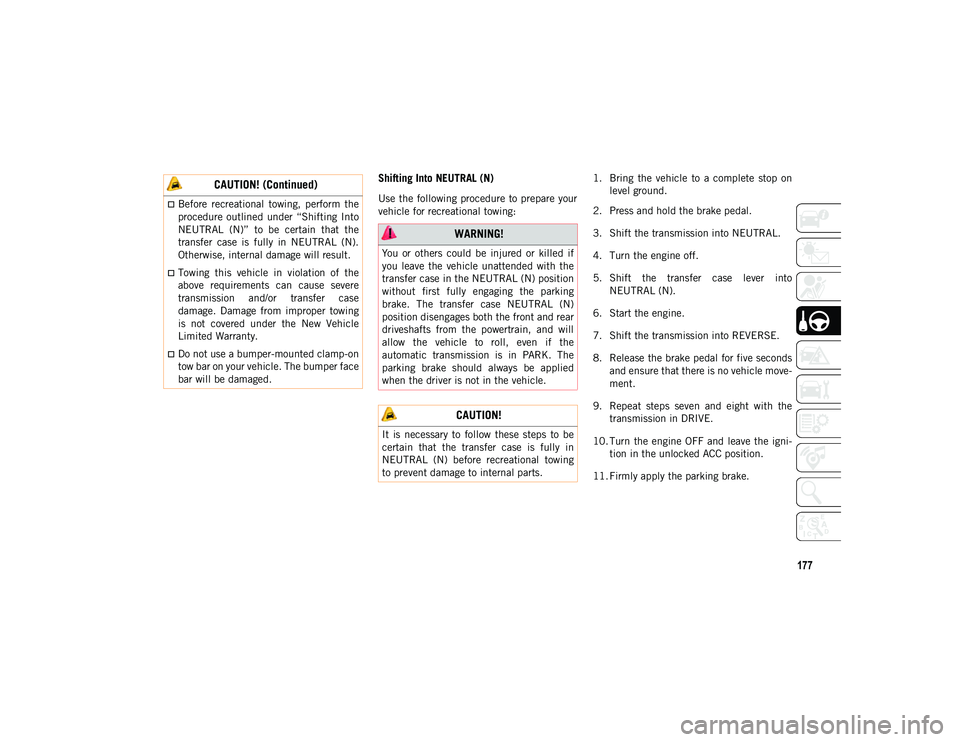
177
Shifting Into NEUTRAL (N)
Use the following procedure to prepare your
vehicle for recreational towing:1. Bring the vehicle to a complete stop on
level ground.
2. Press and hold the brake pedal.
3. Shift the transmission into NEUTRAL.
4. Turn the engine off.
5. Shift the transfer case lever into NEUTRAL (N).
6. Start the engine.
7. Shift the transmission into REVERSE.
8. Release the brake pedal for five seconds and ensure that there is no vehicle move -
ment.
9. Repeat steps seven and eight with the transmission in DRIVE.
10. Turn the engine OFF and leave the igni -
tion in the unlocked ACC position.
11. Firmly apply the parking brake.’ü»Before recreational towing, perform the
procedure outlined under ŌĆ£Shifting Into
NEUTRAL (N)ŌĆØ to be certain that the
transfer case is fully in NEUTRAL (N).
Otherwise, internal damage will result.
’ü»Towing this vehicle in violation of the
above requirements can cause severe
transmission and/or transfer case
damage. Damage from improper towing
is not covered under the New Vehicle
Limited Warranty.
’ü»Do not use a bumper-mounted clamp-on
tow bar on your vehicle. The bumper face
bar will be damaged.
CAUTION! (Continued)
WARNING!
You or others could be injured or killed if
you leave the vehicle unattended with the
transfer case in the NEUTRAL (N) position
without first fully engaging the parking
brake. The transfer case NEUTRAL (N)
position disengages both the front and rear
driveshafts from the powertrain, and will
allow the vehicle to roll, even if the
automatic transmission is in PARK. The
parking brake should always be applied
when the driver is not in the vehicle.
CAUTION!
It is necessary to follow these steps to be
certain that the transfer case is fully in
NEUTRAL (N) before recreational towing
to prevent damage to internal parts.
2020_JEEP_JL_WRANGLER_UG_RHD_UK.book Page 177
Page 181 of 330
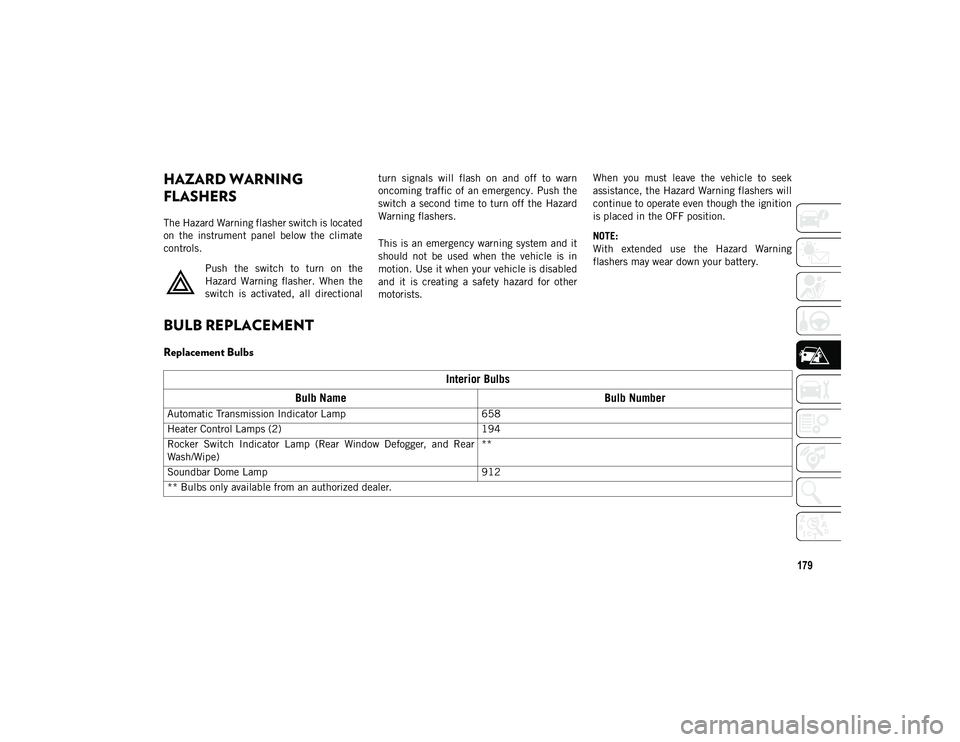
179
IN CASE OF EMERGENCY
HAZARD WARNING
FLASHERS
The Hazard Warning flasher switch is located
on the instrument panel below the climate
controls.Push the switch to turn on the
Hazard Warning flasher. When the
switch is activated, all directional turn signals will flash on and off to warn
oncoming traffic of an emergency. Push the
switch a second time to turn off the Hazard
Warning flashers.
This is an emergency warning system and it
should not be used when the vehicle is in
motion. Use it when your vehicle is disabled
and it is creating a safety hazard for other
motorists. When you must leave the vehicle to seek
assistance, the Hazard Warning flashers will
continue to operate even though the ignition
is placed in the OFF position.
NOTE:
With extended use the Hazard Warning
flashers may wear down your battery.
BULB REPLACEMENT
Replacement Bulbs
Interior Bulbs
Bulb Name Bulb Number
Automatic Transmission Indicator Lamp 658
Heater Control Lamps (2) 194
Rocker Switch Indicator Lamp (Rear Window Defogger, and Rear
Wash/Wipe) **
Soundbar Dome Lamp 912
** Bulbs only available from an authorized dealer.
2020_JEEP_JL_WRANGLER_UG_RHD_UK.book Page 179
Page 196 of 330
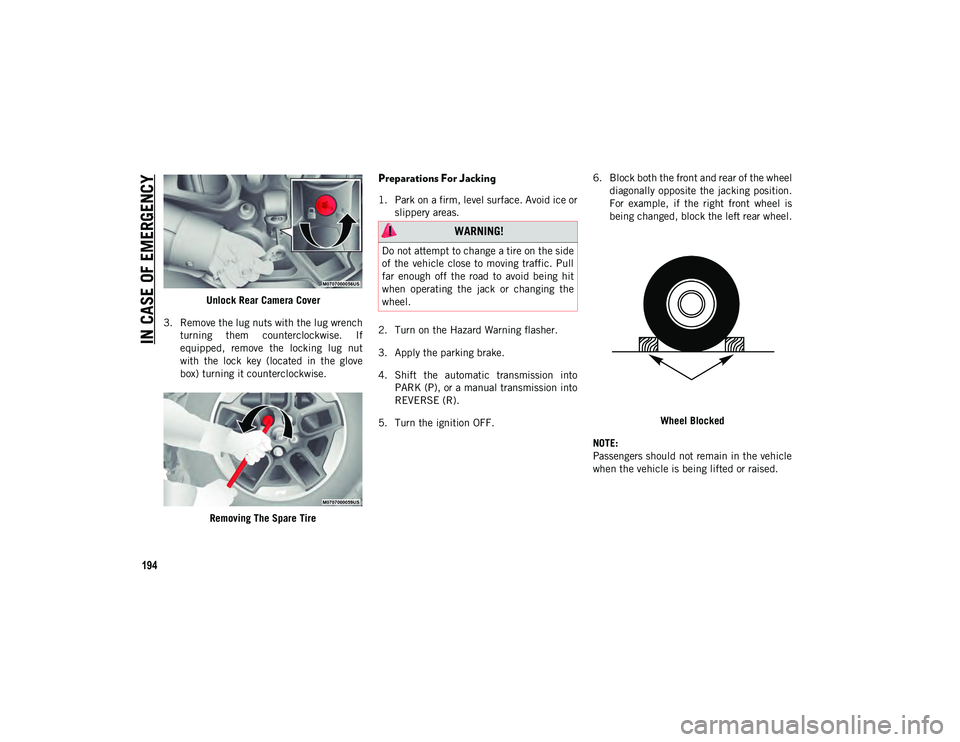
IN CASE OF EMERGENCY
194
Unlock Rear Camera Cover
3. Remove the lug nuts with the lug wrench turning them counterclockwise. If
equipped, remove the locking lug nut
with the lock key (located in the glove
box) turning it counterclockwise.
Removing The Spare Tire
Preparations For Jacking
1. Park on a firm, level surface. Avoid ice orslippery areas.
2. Turn on the Hazard Warning flasher.
3. Apply the parking brake.
4. Shift the automatic transmission into PARK (P), or a manual transmission into
REVERSE (R).
5. Turn the ignition OFF. 6. Block both the front and rear of the wheel
diagonally opposite the jacking position.
For example, if the right front wheel is
being changed, block the left rear wheel.
Wheel Blocked
NOTE:
Passengers should not remain in the vehicle
when the vehicle is being lifted or raised.
WARNING!
Do not attempt to change a tire on the side
of the vehicle close to moving traffic. Pull
far enough off the road to avoid being hit
when operating the jack or changing the
wheel.
2020_JEEP_JL_WRANGLER_UG_RHD_UK.book Page 194